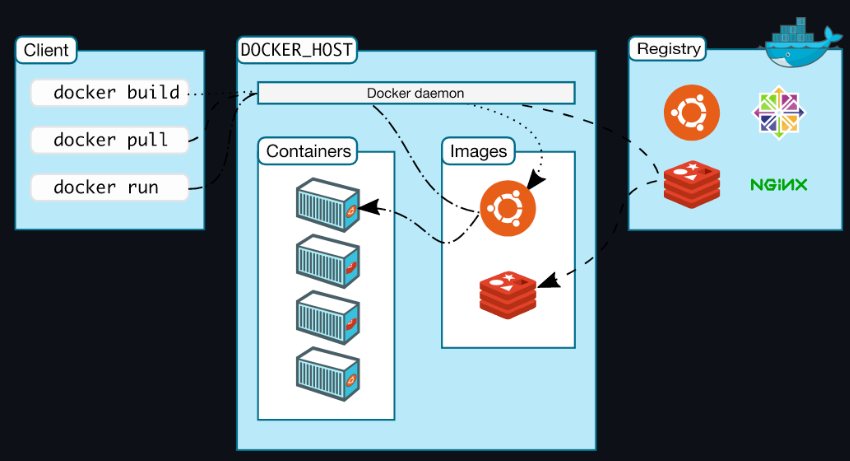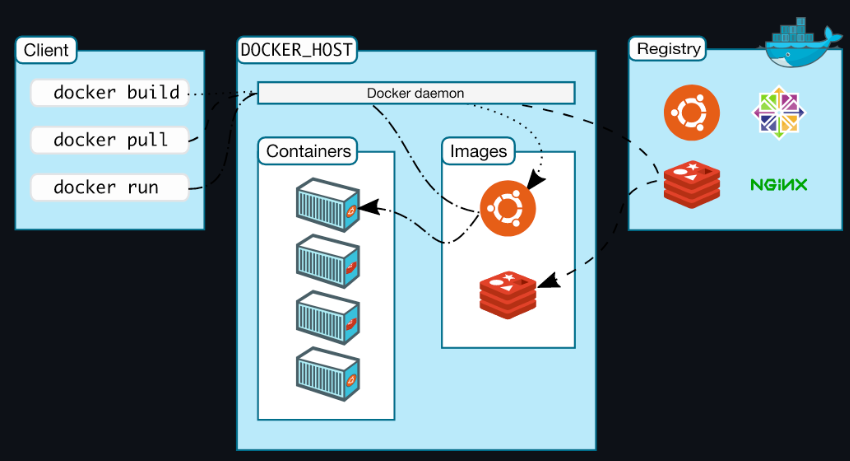Docker Fundamentals: A Comprehensive Overview
 Shivani Tiwari
Shivani Tiwari
Docker has revolutionized the way we develop, deploy, and manage applications. Its client-server architecture, along with its powerful tools and components, makes it a favorite among developers. In this blog post, we’ll dive into Docker fundamentals, exploring its architecture, key components, and lifecycle, providing you with a solid foundation to leverage Docker for your projects.
Docker Architecture: The Client-Server Model:-

At its core, Docker operates on a client-server architecture. The Docker client communicates with the Docker daemon, which is responsible for building, running, and distributing Docker containers. The client and daemon can run on the same machine, or you can connect the client to a remote daemon.
Key Directories in Docker Base Images
Understanding the structure of Docker base images is crucial for effective container management. Here’s a breakdown of key directories:
/bin: Contains essential binary executable files like
ls,cp, andps./sbin: Holds system binary executables such as
initandshutdown./etc: Home to configuration files for various system services.
/lib: Contains library files used by binary executables.
/usr: Houses user-related files and utilities, including applications, libraries, and documentation.
/var: Stores variable data like log files, spool files, and temporary files.
/root: The home directory of the root user.
Host Resources Used by Containers
Containers interact with the host system in several ways:
File System: Containers can access the host file system via bind mounts, enabling read and write operations.
Networking Stack: Provides network connectivity, allowing containers to connect to the host’s network.
System Calls: The host kernel manages system calls from containers, granting access to CPU, memory, and I/O.
Namespaces: Create isolated environments for container processes, covering the file system, process IDs, and networks.
Control Groups (cgroups): Limit and manage the resources a container can use, such as CPU, memory, and I/O.
Docker Components: Building Blocks of Docker
Docker’s architecture includes several key components:
Docker Client
The primary interface for users, the Docker client, communicates with the Docker daemon to execute commands. When you run commands like docker run, the client sends these requests to the daemon.
Docker Daemon
The Docker daemon (dockerd) is the core of Docker, managing objects such as images, containers, networks, and volumes. It also handles API requests and can interact with other daemons to manage Docker services.
Docker Registry
Docker images are stored in a Docker registry. Docker Hub is the default public registry, but you can also set up private registries. Commands like docker pull and docker push interact with these registries to retrieve or upload images.
Docker Objects: Images, Containers, Volumes, and Networks
Images
An image is a read-only template used to create Docker containers. Images can be built from a Dockerfile, which defines the steps needed to create the image. Each step in a Dockerfile adds a layer to the image, making updates efficient and quick.
Containers
Containers are runtime instances of images. They include the application and its dependencies, ensuring consistency across different environments. You can manage containers using the Docker CLI or API, performing operations like start, stop, and destroy.
Volumes
Volumes are used for persistent storage, separate from the container’s lifecycle. They allow data to be shared between containers or persisted across container restarts.
Networks
Docker networks enable communication between containers. There are several network drivers, including Bridge, Host, Overlay, none, and Macvlan, each providing different networking capabilities.
The Docker Lifecycle: Build, Run, Push
The Docker lifecycle involves three main steps:
Build: Create Docker images from a Dockerfile using
docker build.Run: Launch containers from images using
docker run.Push: Upload images to a registry with
docker push, sharing them with others or using them in different environments.
Understanding Docker Desktop
Docker Desktop simplifies the use of Docker on Mac, Windows, and Linux environments. It includes Docker daemon, Docker client, Docker Compose, Docker Content Trust, Kubernetes, and Credential Helper, making it a comprehensive tool for building and sharing containerized applications.
Conclusion:
In conclusion, Docker's architecture and components make it a vital tool for modern application development and deployment. By understanding its core concepts and lifecycle, you can utilize Docker to streamline workflows and ensure consistency across environments. Dive in, experiment, and elevate your containerization skills with Docker.
Happy Dockering!
Subscribe to my newsletter
Read articles from Shivani Tiwari directly inside your inbox. Subscribe to the newsletter, and don't miss out.
Written by
